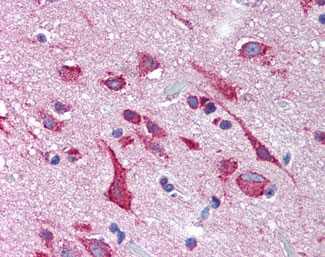KCNH2 / HERG Antibody (Internal)
Rabbit Polyclonal Antibody
- SPECIFICATION
- CITATIONS
- PROTOCOLS
- BACKGROUND

Application
| IHC-P |
|---|---|
| Primary Accession | Q12809 |
| Reactivity | Human, Mouse, Rabbit, Hamster, Monkey, Pig, Horse, Bovine, Dog |
| Host | Rabbit |
| Clonality | Polyclonal |
| Calculated MW | 127kDa |
| Dilution | IHC-P (5 µg/ml) |
| Gene ID | 3757 |
|---|---|
| Other Names | Potassium voltage-gated channel subfamily H member 2, Eag homolog, Ether-a-go-go-related gene potassium channel 1, ERG-1, Eag-related protein 1, Ether-a-go-go-related protein 1, H-ERG, hERG-1, hERG1, Voltage-gated potassium channel subunit Kv11.1, KCNH2, ERG, ERG1, HERG |
| Target/Specificity | Human KCNH2 / Kv11.1. BLAST analysis of the peptide immunogen showed no homology with other human proteins. |
| Reconstitution & Storage | Long term: -70°C; Short term: +4°C |
| Precautions | KCNH2 / HERG Antibody (Internal) is for research use only and not for use in diagnostic or therapeutic procedures. |
| Name | KCNH2 (HGNC:6251) |
|---|---|
| Function | Pore-forming (alpha) subunit of voltage-gated inwardly rectifying potassium channel (PubMed:10219239, PubMed:10753933, PubMed:10790218, PubMed:10837251, PubMed:11997281, PubMed:12063277, PubMed:18559421, PubMed:22314138, PubMed:22359612, PubMed:26363003, PubMed:27916661, PubMed:9230439, PubMed:9351446, PubMed:9765245). Channel properties are modulated by cAMP and subunit assembly (PubMed:10837251). Characterized by unusual gating kinetics by producing relatively small outward currents during membrane depolarization and large inward currents during subsequent repolarization which reflect a rapid inactivation during depolarization and quick recovery from inactivation but slow deactivation (closing) during repolarization (PubMed:10219239, PubMed:10753933, PubMed:10790218, PubMed:10837251, PubMed:11997281, PubMed:12063277, PubMed:18559421, PubMed:22314138, PubMed:22359612, PubMed:26363003, PubMed:27916661, PubMed:9230439, PubMed:9351446, PubMed:9765245). Forms a stable complex with KCNE1 or KCNE2, and that this heteromultimerization regulates inward rectifier potassium channel activity (PubMed:10219239, PubMed:9230439). |
| Cellular Location | Cell membrane; Multi-pass membrane protein |
| Tissue Location | Highly expressed in heart and brain. Isoforms USO are frequently overexpressed in cancer cells |

Thousands of laboratories across the world have published research that depended on the performance of antibodies from Abcepta to advance their research. Check out links to articles that cite our products in major peer-reviewed journals, organized by research category.
info@abcepta.com, and receive a free "I Love Antibodies" mug.
Provided below are standard protocols that you may find useful for product applications.
Background
Pore-forming (alpha) subunit of voltage-gated inwardly rectifying potassium channel. Channel properties are modulated by cAMP and subunit assembly. Mediates the rapidly activating component of the delayed rectifying potassium current in heart (IKr). Isoforms USO have no channel activity by themself, but modulates channel characteristics by forming heterotetramers with other isoforms which are retained intracellularly and undergo ubiquitin-dependent degradation.
References
Warmke J.W.,et al.Proc. Natl. Acad. Sci. U.S.A. 91:3438-3442(1994).
Itoh T.,et al.Hum. Genet. 102:435-439(1998).
Soejima H.,et al.Genomics 74:115-120(2001).
Downie D.,et al.Submitted (MAR-2001) to the EMBL/GenBank/DDBJ databases.
Crociani O.,et al.J. Biol. Chem. 278:2947-2955(2003).
If you have used an Abcepta product and would like to share how it has performed, please click on the "Submit Review" button and provide the requested information. Our staff will examine and post your review and contact you if needed.
If you have any additional inquiries please email technical services at tech@abcepta.com.













 Foundational characteristics of cancer include proliferation, angiogenesis, migration, evasion of apoptosis, and cellular immortality. Find key markers for these cellular processes and antibodies to detect them.
Foundational characteristics of cancer include proliferation, angiogenesis, migration, evasion of apoptosis, and cellular immortality. Find key markers for these cellular processes and antibodies to detect them. The SUMOplot™ Analysis Program predicts and scores sumoylation sites in your protein. SUMOylation is a post-translational modification involved in various cellular processes, such as nuclear-cytosolic transport, transcriptional regulation, apoptosis, protein stability, response to stress, and progression through the cell cycle.
The SUMOplot™ Analysis Program predicts and scores sumoylation sites in your protein. SUMOylation is a post-translational modification involved in various cellular processes, such as nuclear-cytosolic transport, transcriptional regulation, apoptosis, protein stability, response to stress, and progression through the cell cycle. The Autophagy Receptor Motif Plotter predicts and scores autophagy receptor binding sites in your protein. Identifying proteins connected to this pathway is critical to understanding the role of autophagy in physiological as well as pathological processes such as development, differentiation, neurodegenerative diseases, stress, infection, and cancer.
The Autophagy Receptor Motif Plotter predicts and scores autophagy receptor binding sites in your protein. Identifying proteins connected to this pathway is critical to understanding the role of autophagy in physiological as well as pathological processes such as development, differentiation, neurodegenerative diseases, stress, infection, and cancer.


